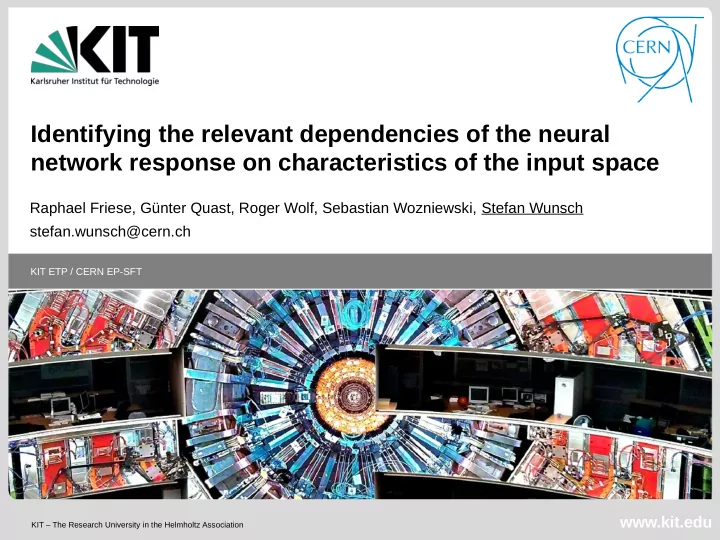

Identifying the relevant dependencies of the neural network response on characteristics of the input space Raphael Friese, Günter Quast, Roger Wolf, Sebastian Wozniewski, Stefan Wunsch stefan.wunsch@cern.ch KIT ETP / CERN EP-SFT www.kit.edu KIT – The Research University in the Helmholtz Association
Example Neural network trained as classifier on a dataset with: ● two variables x 1 and x 2 ● two processes signal and background Is the response of the trained neural network mainly dependent on ● the marginal distributions of x 1 and/or x 2 ? ● the correlation of x 1 and x 2 ? 2
Motivation Neural networks gain importance in physics analyses in comparison to cut-based approaches, but pose new challenges for the estimation of the systematic uncertainties : ● Multi-dimensional “cuts” performed by the neural network are incomprehensibly encoded in numerous free parameters of the architecture. ● Same neural network architecture may perform different tasks based on the training. ● Neural network may exploit higher-dimensional features of the inputs, e.g., correlations, which could be wrongly modeled in the training dataset . Key to proper estimation of systematic uncertainties : Precise understanding of the trained neural network and the relevant dependencies of the neural network response on the inputs . 3
Approach 1) Taylor expansion of the trained neural network 2) Identification of the Taylor coefficients with features of the inputs 0.183 0.136 t i 0.090 0.043 t x 2 t x 1 t x 1 , x 2 t x 2 , x 2 t x 1 , x 1 Features: Marginal distributions Correlations 4
Application on toy scenarios Separation by marginal distributions visible by <t x1 > and <t x2 > . Separation by correlation visible by <t x1,x2 > . 5
Application on toy scenarios Scenarios with a mixture of features can be identified. Separation due to width of distribution visible by <t x1,x1 > and <t x2,x2 > . 6
Visualization of the learning progress Analyzed scenario with mixed features: Performed analysis of Taylor coefficients after each gradient step : First: Learned separation by marginal distributions Second: Learned separation by correlation 7
Application on a physics dataset ● Use dataset from Higgs boson machine learning challenge launched by the ATLAS collaboration in 2014 ● Simulated H→ττ events and events from background processes with similar topologies ● Binary classification task ● Dataset consists of 30 variables (21 low-level and 9 high-level variables) ● Calculate metric of relevance for all features up to 2 nd order 8
30 input variables result in Application on a physics dataset 495 features: ● 30 marginal distributions ● 465 pairs of variables Only a few features are identified as influential . → This knowledge simplifies the estimation of systematics greatly. Mass variables are identified as highly important while Φ variables are rated as less significant . → Matches the expectation from physics. 9
Application on a physics dataset Comparison of performance for: ● Training on 30 variables of full dataset ● Training on 9 variables contributing to upper 5% of most important features ● Training on 21 variables of inverted selection Immense reduction of dimensionality without loss of performance. 10
Application on a physics dataset 9 variables contributing to upper 5% of most important features : Identified variables ● DER_mass_MMC used in physics analyses by CMS ● DER_mass_vis and ATLAS for signal ● DER_mass_jet_jet discrimination as most important. ● DER_deltar_tau_lep ● DER_pt_ratio_lep_tau ● DER_mass_transverse_met_lep ● PRI_lep_pt ● PRI_tau_pt ● PRI_jet_all_pt 11
Summary ● Proposed usage of Taylor expansion of neural network function to identify relevant dependencies of the neural network response on characteristics of the inputs . ● Toy studies presented the application of the approach in well-defined scenarios. ● Application of the approach on a physics dataset shows the usability in physics analyses supporting the in-depth understanding of the trained neural network to facilitate the estimation of systematic uncertainties . ● Paper with all details is already submitted and available as pre-print on arXiv here . 12
Recommend
More recommend